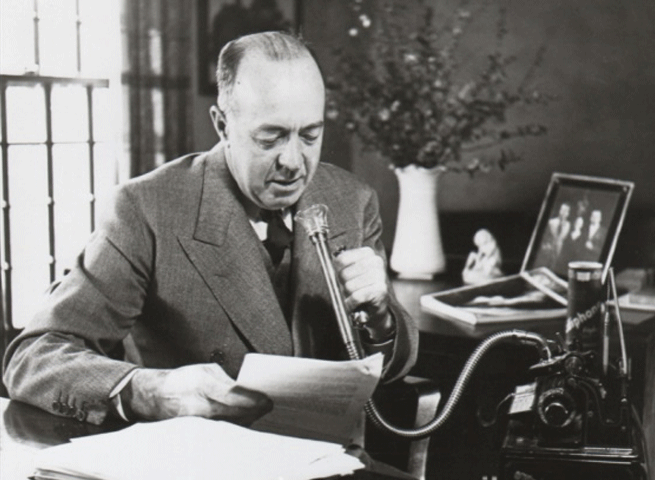Edgar Rice Burroughs Dictated His Work — So I Tried It
 Over his nearly forty-year career, Edgar Rice Burroughs put into use every writing method available to him. In a letter to the Thomas A. Edison Company regarding their Ediphone machine, which ERB purchased in 1922, he wrote: “I have written longhand and had my work copied by a typist; I have typed my manuscripts personally; I have dictated them to a secretary; and I have used the Ediphone.” (He didn’t mention in the letter that he also used the Dictaphone, Edison’s competitor.) Although Burroughs would shift his writing methods over the decade and sometimes returned to the trusty typewriter — even letting a ghostly force take over the typing duties in the prologue to Beyond the Farthest Star — wax cylinder dictation machines became his preferred tool. In his daily log of writing progress, he’d describe his workload in terms of how many wax cylinders he’d gone through that day. “May 24 Dictated 5 cyl. today — something over 4000 words.”
Over his nearly forty-year career, Edgar Rice Burroughs put into use every writing method available to him. In a letter to the Thomas A. Edison Company regarding their Ediphone machine, which ERB purchased in 1922, he wrote: “I have written longhand and had my work copied by a typist; I have typed my manuscripts personally; I have dictated them to a secretary; and I have used the Ediphone.” (He didn’t mention in the letter that he also used the Dictaphone, Edison’s competitor.) Although Burroughs would shift his writing methods over the decade and sometimes returned to the trusty typewriter — even letting a ghostly force take over the typing duties in the prologue to Beyond the Farthest Star — wax cylinder dictation machines became his preferred tool. In his daily log of writing progress, he’d describe his workload in terms of how many wax cylinders he’d gone through that day. “May 24 Dictated 5 cyl. today — something over 4000 words.”
In the letter to the Edison Company, Burroughs listed the reasons he preferred to work using dictation machines: “Voice writing makes fewer demands upon the energy … it eliminates the eyestrain … the greatest advantage lies in the speed. I can easily double my output.” He kept his Ediphone (or Dictaphone) near his bedside “to record those fleeting inspirations that would otherwise be lost forever.”
At the time, dictation machines were primarily used for businesses. In order to make the most out of one, a writer had to have a stenographer to transcribe the wax cylinder recordings, so dictation machines weren’t much use to pulp fiction writers. But Edgar Rice Burroughs was both a writer and a business. He was wealthy enough to have an office staff, including a secretary whose job was to type up the manuscript from ERB’s cylinder output. The secretary would also do the job of shaving each wax cylinder — this required its own machine — so it could be reused.
 Most pulp writers of the 1930s were itching to break into the hardcover book market. Since reprints of pulp stories in book form were rare at the time, these writers did not expect that their work for the newsstands would survive past an issue’s sell-date. They felt comfortable re-working and expanding on them to create novels. Raymond Chandler famously called his process of novelizing his already published work as “cannibalizing.” He welded together different short stories, often keeping large sections of text intact with only slight alterations. Other authors took ideas that they liked, or else felt they could do more justice to in the novel format, and enlarged them into books without text carry-over. Robert E. Howard used “The Scarlet Citadel” as a guide for The Hour of the Dragon. And Cornell Woolrich turned many of his short stories into novels. “Face Work” became The Black Angel. “Call Me Patrice” became I Married a Dead Man. “The Street of Jungle Death” became Black Alibi. And “Speak to Me of Death” became Woolrich’s most depressing novel (which is really saying something), Night Has a Thousand Eyes.
Most pulp writers of the 1930s were itching to break into the hardcover book market. Since reprints of pulp stories in book form were rare at the time, these writers did not expect that their work for the newsstands would survive past an issue’s sell-date. They felt comfortable re-working and expanding on them to create novels. Raymond Chandler famously called his process of novelizing his already published work as “cannibalizing.” He welded together different short stories, often keeping large sections of text intact with only slight alterations. Other authors took ideas that they liked, or else felt they could do more justice to in the novel format, and enlarged them into books without text carry-over. Robert E. Howard used “The Scarlet Citadel” as a guide for The Hour of the Dragon. And Cornell Woolrich turned many of his short stories into novels. “Face Work” became The Black Angel. “Call Me Patrice” became I Married a Dead Man. “The Street of Jungle Death” became Black Alibi. And “Speak to Me of Death” became Woolrich’s most depressing novel (which is really saying something), Night Has a Thousand Eyes.